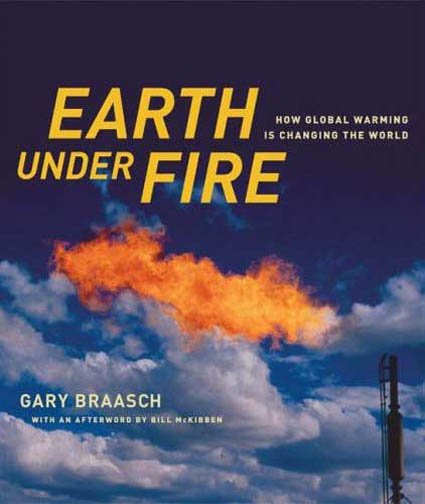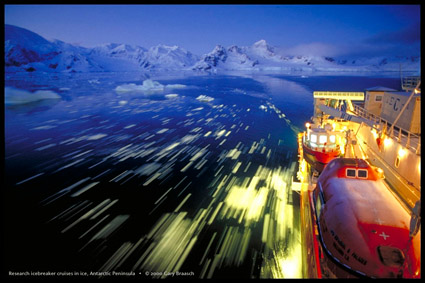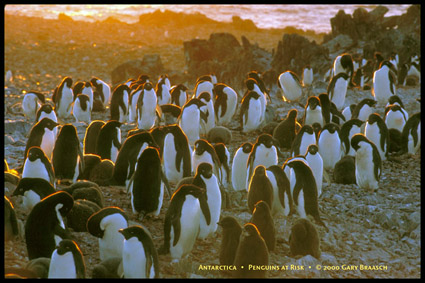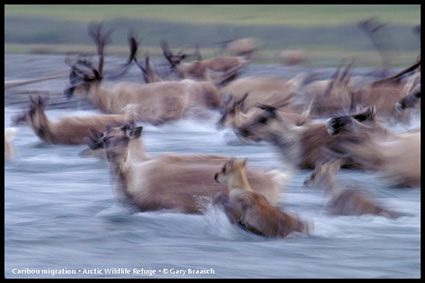Gary Braasch – Earth Under Fire

Gary Braasch has photographed climate change more extensively than any other photographer. His book Earth Under Fire is a definitive work on the subject.
Find out about Gary Braasch here.
Find out about Earth Under Fire here.
Gary and I have been talking at length on many subjects. Here’s the first installment of our conversations.
John Paul Caponigro
Tell me about climate change. And tell me about your book – Earth Under Fire.
Gary Braasch
In June 1997 I was stuck in a cold tent on the Alaska tundra with fellow nature photographer Gerry Ellis. We had come to photograph caribou and other tundra animals, but for these weeks, anyway, we saw very little. But while we read our books in the tent and talked of life and photography, we also chatted about the major issues in nature and conservation. What were we going to do in coming years: what locations, what species, what issues were going to be the most important to photograph?. And also, who was going to hire, publish and pay us for this?
As it turned out, that otherwise really boring time on the tundra was partly a turning point for both Gerry and me (he had started a stock agency but had his eyes on education and the protection of baby animals in Africa; that work, “Wild Orphans,” became his NGO, Globio). I generated lists of environmental issues and realized that climate change was possibly going to be really important, but no one was photographing it.
Before I left Alaska that year, I had not only found a huge herd of caribou to photograph, but I also talked to some scientists about how Alaska was warming. And I went out by way of Prudhoe Bay, seeing and smelling the industrial oil field. I also met the crew of a Greenpeace ship that was bird-dogging a drilling platform offshore. They were already committed about the connection between fossil fuel and global warming. The science, the wilderness, the source of oil and the issue all began to come together for me. About a year later, an article by Bill McKibben in Atlantic Monthly about how everything we do makes and is affected by greenhouse gases further inspired me. On my copy of that article I scrawled the idea: “World tour of global warming.”
But how to approach such a huge subject? I knew from reading science journals and reports that scientists were seeing changes in many places, sharp turns from the slow change seen in years and years of measurements and data, shifts that seemed to correlate only to rising earth temperatures and added CO2. Because popular articles and books on climate change were based on predictions, which are easily dismissed, I wanted to look at the Earth itself and report on the changes already under way. As a journalist, I wanted to move beyond the raw statistics, the secondhand and political arguments, and talk directly to the scientists who are documenting it. So, since I had shot many stories of scientists in the field (like about the spotted owl) I began emailing or calling a few of the leading researchers to ask to come document their field work. I also would ask where changes were the most visible and what other indicators there were of global warming. I wrote my first project description:
“The goal of World View of Global Warming is to illustrate the physical changes and compelling science on all continents, which show that global warming and other climate shifts have begin. Too often public information and political debate lack a basis in science and are without a vision of how the earth is changing.
Working with private grants and magazine assignments, I will visit those locations where climate science is undertaken and where effects of global warming have been documented. As often as possible my photographs will actually show changes (or comparisons with old photographs).
World View of Global Warming benefits from a dialogue with scientists and observers around the world who have provided hundreds of scientific contacts and papers. In the initial phase ending in 2001, I am focusing on polar regions, shrinking glaciers around the world, coral bleaching, insect and animal range changes, and rising sea level. Images will appear in magazines and books.”
My first act was to pull my research into shape, and make a more formal list of locations to photograph. Thinking (rightly as it turned out) that I could not rely on too many magazine assignments, I applied to Blue Earth Alliance (www.blueearth.org <http://www.blueearth.org> a tax exempt photography support NGO founded by photographers Natalie Fobes and Phil Borges]. By December 1998, my proposal received backing from Blue Earth and initial funding was secured from a family environmental fund with which I had previously had contact.
I have to say that at this point I had little idea of what I was getting into – how many studies there were, how much it would really cost, how rapidly climate science would develop, or what controversy it would raise. Global warming was already an issue and battle lines had been drawn: Al Gore had returned from the Kyoto climate meetings but the US Senate refused to consider the Protocol and the Clinton Administration did not push it. The 2000 election campaign was still in the future and the world’s scientists were just writing drafts of their famous 2001 IPCC report – both events which would change the face of our national reaction to rapid climate change.
Early in 1999 I cranked up my contact with climate scientists I already knew, most from my previous Alaska work. I put out the word to my magazine editor list, seeking assignments and other scientific contacts. I already had work coming up in the Peruvian Amazon, so I added on a week of travel into the Andes to photograph receding glaciers, using contacts I found through The Mountain Institute. I arranged to travel later in the year with some of the scientists I knew in Alaska who were studying change on the tundra. The big break came from a contact I had previously made at Life magazine, Steve Petranek, who had become editor at Discover magazine. He saw my emails about my new project and hired me to accompany a writer on a National Science Foundation geologic research cruise to Antarctic Peninsula ice sheets and glaciers in April 1999. The next year I parlayed this into my own return trip, using research about Southern Giant Petrels( which I had learned about while in Antarctica) to gain an assignment for International Wildlife. While on this second trip, I used every opportunity to learn more about and photograph climate change. I had never been to Antarctic before these trips in 1999 and 2000 – but now not only did I have a complete story about change down there, but was also able to gain more visibility as a nature photographer with scientifically-accurate images of Antarctica. I was getting off to a great start.
Of far greater importance than the process of the project and the individual photos I began to make, was my role as a witness to climate change.

No need to remind of what happened in the 2000 election, of the anti-science Administration that George W. Bush installed, of the horror of 9/11 and the near total focus it created on war and national defense. Global warming was thoroughly off the radar and actively dismissed by the government and many corporations and their PR flacks. Through all of this scientists continued to work, putting out a world review of effects and changes in 2001 and an even stronger and better documented one in 2007. Through all of this I followed as — at first — the only photographer that I knew of on a full time climate project (even now there are only about 10 of us who focus on it a great deal).
My photographs, seen in Discover Magazine, on the NRDC website and in an exhibit they curated along with the AAAS scientists organization, began to be seen. In 2001 and 2002 I established my website. And the requests for images from teachers, magazines, websites, citizens organizations and scientists themselves began to come in. By the time I got a book contract from University of California Press in 2004 and completed my list of must-photograph locations the next year, I had been to 22 nations and all continents.
I was a witness to what otherwise were just numbers or facts in news stories: I have stood in the empty rookeries of displaced Adelie penguins and photographed huge icebergs separated from an ice shelf in Antarctica. I have seen the jagged fronts of receding Greenland glaciers and observed subtle changes on the tundra. I have tracked down Alpine glaciers depicted in 150-year-old images and rephotographed them to show them wasting away. In the woods of eastern North America I have walked among spring wildflowers and watched for migrant songbirds, which are arriving earlier each season than in decades past. Along the coasts I have seen rising tides and heavy storms erode beaches. I have heard the anguish in the voices of native Alaskans as they describe their village being washed away, of Chinese farmers facing famine caused by drought, and of Pacific Islanders driven from their homes by increasingly high tides.
Photographing this subject presents a great challenge. Changes have been unfolding for fifty years or more, with most effects being incremental, or invisible. Pictures are not science; they can, however, provide direct evidence that global warming is happening now, all over the world. They provide contact with eyewitnesses—lifelong observers, Native peoples, and teams of scientists who are seeing rapid change across the expanse of Earth’s living systems. Pictures also show that the effects of global warming are taking place in Earth’s most beautiful and sensitive landscapes, especially at the extremities of our planet—at the poles, high in the mountains, and in the ocean’s rich nearshore environments. Animals and plants on the edge of their ranges, as well as people who live on shorelines or who still subsist from nature, are the first to feel the effects.
The photographs in Earth Under Fire: How Global Warming is Changing the World helped to make real the scientific evidence that entire cultures, ecosystems, and species are being forced into transition, the continued existence of some of them threatened by our use and abuse of fossil fuels and the soil of the earth.
Stay tuned for more with Gary in the coming weeks.



No Comments